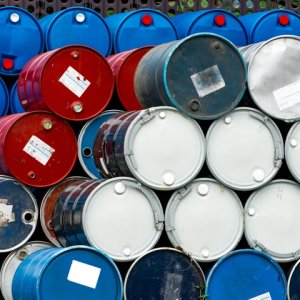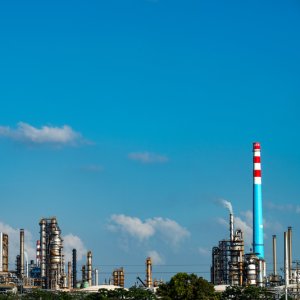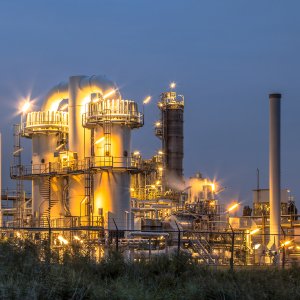
Reviving the Petchem Sector with Etileno XXI
The state of Veracruz has always been a center for downstream activity in Mexico. Since the Minatitlán refinery was constructed in 1906 many downstream facilities have been built in the state, and today Veracruz is home to much of Mexico’s petrochemical production. It was in this industrial environment that the Etileno XXI project was devised by both private and public stakeholders, as part of an eort to modernize the industrial production of petrochemicals.
According to Roberto Bischo, Director General of the Braskem-Idesa consortium, “Mexico is one of the few places in the world that can combine all of the key drivers for a successful petrochemical project.” José Luis Uriegas, CEO of Grupo Idesa, agrees with his Braskem-Idesa counterpart that all of the elements necessary for building a successful petrochemical operation on a large scale are present in Mexico. This is what has made companies see Veracruz as a perfect location for their downstream ambitions in the country. “We are building a plant in the south of Veracruz, in a small city called Nanchital near Coatzacoalcos, which has only 80,000 habitants,” Bischo tells us. “The area contains all three of Pemex’s petrochemical complexes in a radius of 20km, and it is also close to the Minatitlán refinery, which gives us easy access to a consistent supply of feedstock.”
Both Braskem and Grupo Idesa have developed big projects in the petrochemical segment. “To build a successful petrochemical project, you have to take several factors into consideration,” says Uriegas. “First of all, you need to have access to highly sought after raw materials on a long-term basis. Veracruz has the feedstock needed to start a project this big. Once you have the raw materials, you need access to the markets that demand your end products. Mexico has significant demand from its domestic market, and it also has free-trade agreements with 44 countries to which Mexican petrochemical producers can export with no taris.” The geographical location of Mexico also eases access to the US market, which has a lot of export potential. “The third vital element is the technology needed to build the cracker, which was available to us here in Mexico, since we bought it from Technip,” Uriegas continues. “Apart from technology, the final element needed is human talent. Veracruz has a very welldeveloped and experienced workforce for the petrochemical sector, which gave us all we needed to set this business up.”
Approximately 70% of the polyethylene currently used in the country is imported, which amounts to around 1.1 million tons per year, and around 90% of that comes from the US. The figure is expected to increase to 1.5 million tons by 2015. The Etileno XXI complex is expected to produce 1 million tons of ethylene per year by the time of its start-up, to be fully targeted towards the Mexican market. Its facilities will include two polyethylene plants producing 750,000 tons per day and one low-benzene polyethylene plant producing an additional 300,000 tons on a 1:1 ethylene to polyethylene ratio. It is expected that by 2015 the plant’s production will replace most of the imports that currently satisfy domestic demand. “Mexico will continue to grow at an annual rate of 3-4%, and so will the market for polyethylene,” Bischo says. “This means that the production from Etileno XXI will become strategic in replacing imports, but will not eliminate them; imports will continue to play an important role in supplying the domestic market.” The project is currently under construction with an estimated completion date of 2015, but it took many years for the Mexican government to accept the proposal. In the late 1990s, during the term of President Ernesto Zedillo Ponce de León, the project was thought of as a solution to modernizing the petrochemical sector in Mexico; however, despite some discussion around the topic the project did not get o the ground. By President Vicente Fox Quesada’s term, the conversations about starting such a project re-emerged under the codename of Project Fenix. “At that time we were working with other companies, such as Grupo Alfa in Mexico, to participate in the project,” recalls Uriegas. “But unfortunately, Fenix was also discarded during that administration.” More than a decade after the project was originally proposed Felipe Calderón Hinojosa, former Energy Minister, was elected President and decided to support the project. “President Calderón had seen the draft proposal for this project during his term at the Ministry of Energy and strongly supported the idea; he wanted to finance the project and intervened to make it happen,” Uriegas states. “He called on all of the players that needed to get involved – the Ministries of Energy, Finance and Economy, and Pemex – and put together a strong team to establish the basis to put out a contracting tender.” This was how Etileno XXI was born.
Several petrochemical companies rekindled their interest in the Mexican market under the conditions of the Etileno XXI project tender. “The Mexican government made sure that the necessary long-term stability and provisions were there for such an important project,” says Bischo. Both Braskem and Grupo Idesa became involved during the early stages of the contracting process; after meeting and discussing several ideas, they decided that it would make strategic sense for them to combine forces in a joint venture. “We had the experience of doing business in the petrochemical sector in Mexico and managing the distribution and storage of refined oil products; however, we had no experience in crackers nor in any part of the manufacturing process of petrochemicals, since that was all monopolized by Pemex,” Uriegas recalls. “Braskem brought considerable experience to the construction of crackers and the manufacture of polyethylene, resulting from its work in Brazil.” The skillsets of both companies complemented each other very well and helped them to overcome the challenges that they later faced at Etileno XXI. In order to align their partnership strategies, Braskem and Grupo Idesa decided to consolidate their alliance by creating a Mexican company with a 75% stake for the Brazilian company, and a 25% stake for its Mexican counterpart Idesa. It was not the first time that Braskem had looked for a project like this: the Brazilian company had been searching for opportunities throughout South America for several years, and finally decided to invest in Mexico, where, for engineering purposes, we have joined together with them and ICA Fluor.”
The project’s FEED stage has already been completed by Technip, and the contract for the EPC stage is now under way. The consortium, consisting of Odebrecht (40%), Technip (40%), and ICA Fluor (20%), will be in charge of delivering the engineering specifications for the project and building the plants. “Both Odebrecht and ICA Fluor are experts in construction and, with the acquisition of Stone & Webster, we now own around 50% of the world’s ethylene technology,” Pescador Asaf states. “In this regard, the consortium we have put together fulfills the EPC requirements of the project perfectly.”
















